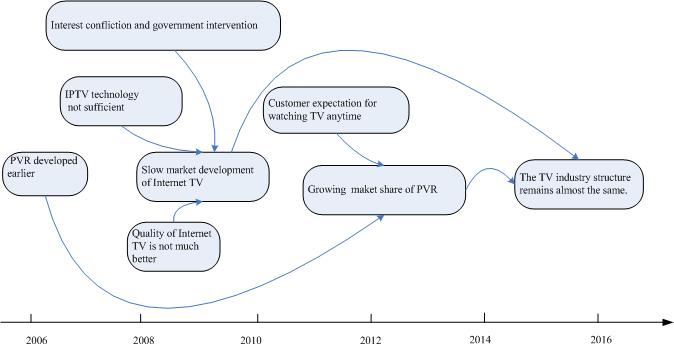Difference between revisions of "Scenario 4: The same TV industry structure"
| (One intermediate revision by the same user not shown) | |||
| Line 1: | Line 1: | ||
PVR absolutely developed earlier and has early market entry than IPTV. In 2007 to 2008, technology of IPTV is still not sufficient and there are a lot of issues or competitions regarding standards. The new entry of IPTV would totally change the current TV industry and there is quite a lot confliction with current industry players. In this competition, the old players are stronger. The government intervenes. It supports the traditional TV distribution way and suppress the development of IPTV. All these result in a slow market development of Internet TV. Customer’s demand for “watching TV at anytime” is increasing all the time. The early development of PVR and customers’ increasing demand for “watching TV at anytime” leads to growing market share of PVR. PVR is a great success. The TV industry structure remains almost the same. Internet TV doesn’t succeed, while PVR wins. <br><br> | |||
[[Image:IPTV-scenario_4.jpg]] | |||
Latest revision as of 05:36, 10 May 2006
PVR absolutely developed earlier and has early market entry than IPTV. In 2007 to 2008, technology of IPTV is still not sufficient and there are a lot of issues or competitions regarding standards. The new entry of IPTV would totally change the current TV industry and there is quite a lot confliction with current industry players. In this competition, the old players are stronger. The government intervenes. It supports the traditional TV distribution way and suppress the development of IPTV. All these result in a slow market development of Internet TV. Customer’s demand for “watching TV at anytime” is increasing all the time. The early development of PVR and customers’ increasing demand for “watching TV at anytime” leads to growing market share of PVR. PVR is a great success. The TV industry structure remains almost the same. Internet TV doesn’t succeed, while PVR wins.
